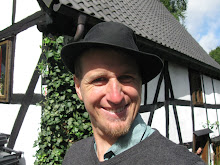
I am in a small town Lilande, on the Dordogne river.
Why? You may have read about my weariness of trains and my longing for the bike. Well, with my first income for several months on the cards (Tomas jacked me up with the sweet wine harvest job) I splashed out on a bike, and locks, and rad panniers that turn into a backpack and two bags.
And so I venture forth into Acquitaine, self contained, dodging the rain, feeling a little pain, (eating le pain, but that doesn't rhyme, I am discovering)
I'm intrigued by the prospect of the river valley turning into a gorge; much more so by the fact that this area is positively chokka with Neaderthal and Cro Magnon caves with their paintings and etchings and so forth. So I'm gonna go see them, of course. When I was little I dreamed about finding dinosaur footprints in hardened mud somewhere: this, I think, might be even more astounding.
On the other hand maybe I will feel like a man who has been a tourist for too long.

So far on the trip I have had two lovely encounters. One was a French couple inviting me into their house to watch the All Blacks vs Scotland, accompanied by sausage, bread, cheese, beer, then chickpeas, onions, barely cooked meat, wine, more bread, more cheese. Jaques was keen to practice his English "What do you think of the organisation of the cup?". Joele was more hardcore. "in my house," she said (in French), "you speak French". So I get frustrated and manage a few sentences an hour, but she teaches me a Moliere quote À vaincre sans péril on triomphe sans gloire.
In Sante Foy de Grande I meet Matt, an English guy who is in the middle of a years stay at Plum Village, a Buddhist community founded by Thich Nat Hanh. Worldly and kind, he is a fascinating character. I hope I see him again, perhaps when he is travelling the world as a clown.















